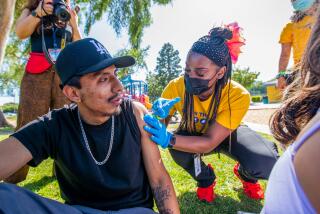If shopping malls across California can reopen, museums should be able to do so too
- Share via
Trying to avoid another surge in the COVID-19 pandemic, California has shut down many indoor businesses and activities until the infection rates in their counties have dropped to more manageable levels. The toughest restrictions remain in place in the dozen counties with the highest rates of positive tests and new cases, including Los Angeles County. It’s a cautious approach rooted in science, which is reassuring and welcome. But it shouldn’t preclude innovative ways to adapt spaces and our use of them to keep people safe.
Here’s one example. Even in counties with widespread transmission, the state has allowed indoor venues such as shopping malls, retail stores, hair salons and tattoo parlors to reopen with restrictions. Museums, however, have been told to keep their indoor galleries closed, even though they have offered to put in place an elaborate array of safety measures. If these facilities can reopen as safely as shopping malls or tattoo parlors, state health officials should find a way to let them do so.
In the state’s assessment, shopping malls generally attract patrons from the local community while museums attract visitors from across the region and beyond. That “raises the risk of COVID-19 transmission due to the amount of mixing of people from different households and communities,” acting state health officer Dr. Erica Pan wrote in a letter to the California Assn. of Museums. She also wrote that visitors spend longer periods of time in museums than they do in shopping malls.
And, she says, mall visitors spend their time in a different way than they do in museums. “There are not things on the wall to stop and talk about,” Pan said in a phone interview. The idea behind the state restrictions is to eliminate places to congregate, which is sensible. When people go into a shopping mall, Pan said, they really should focus on getting what they need and getting out.
They probably should in the age of COVID. But there’s no way to know that shoppers won’t pause to appraise an item of clothing for any less time than museum visitors will pause to appraise a painting. According to a 2017 study on how long visitors to the Art Institute of Chicago viewed artworks, the median time was a scant 28.6 seconds.
Part of the problem here is that state health officials seem stuck on the conventional notion of a museum full of art lovers who roam pensively from room to room, sitting for long stretches to stare at a Rembrandt or a Rothko. That’s not what would happen under the COVID-era restrictions that museums have agreed on and urged the state to accept, including staggering their admissions, limiting themselves to 25% capacity and keeping people flowing through their spaces in a timely and ordered fashion.
If the L.A. County Museum of Art reopened at 25% capacity, “you would feel very alone,” says director Michael Govan. Museums have security personnel minding every gallery who could make sure visitors keep their masks on and speed up or slow down traffic as necessary to maintain physical distancing. Museum visitors are already accustomed to following a lot of rules (don’t touch this painting; don’t lean on that pedestal), so compliance is likely to be high regardless.
Ironically, since retail sites are open even in highly restricted counties, art galleries can open while museums cannot. Pan says the difference is that art galleries are small. But what museums are credibly saying is that they can hold down the number of people who enter and control their flow through the exhibits. Also, state officials may be unnecessarily worried about California museums drawing from outside the county. The directors of LACMA, the Autry Museum of the American West and the Natural History Museum in Exposition Park all say their facilities draw two-thirds to 70% of their visitors from this county. State officials could always impose a requirement that museums open only to that county’s local residents.
In a period of health restrictions that is scarily open-ended, everyone is missing something important to their lives and livelihoods. As the state gradually eases those restrictions, the reopenings have moved beyond the businesses and activities deemed essential (grocery stores, gas stations) to some of the ones that people have been desperately missing. The last thing the state needs at this point is to drop its guard against the coronavirus, especially not with the flu season arriving and colder weather leading people to spend more time clustered indoors. But the vigilance should be accompanied by a willingness to consider how museums and others on the shuttered list can mitigate risks with new approaches that adapt to the threat of a highly contagious disease.
- Share via
Watch L.A. Times Today at 7 p.m. on Spectrum News 1 on Channel 1 or live stream on the Spectrum News App. Palos Verdes Peninsula and Orange County viewers can watch on Cox Systems on channel 99.
More to Read
A cure for the common opinion
Get thought-provoking perspectives with our weekly newsletter.
You may occasionally receive promotional content from the Los Angeles Times.










